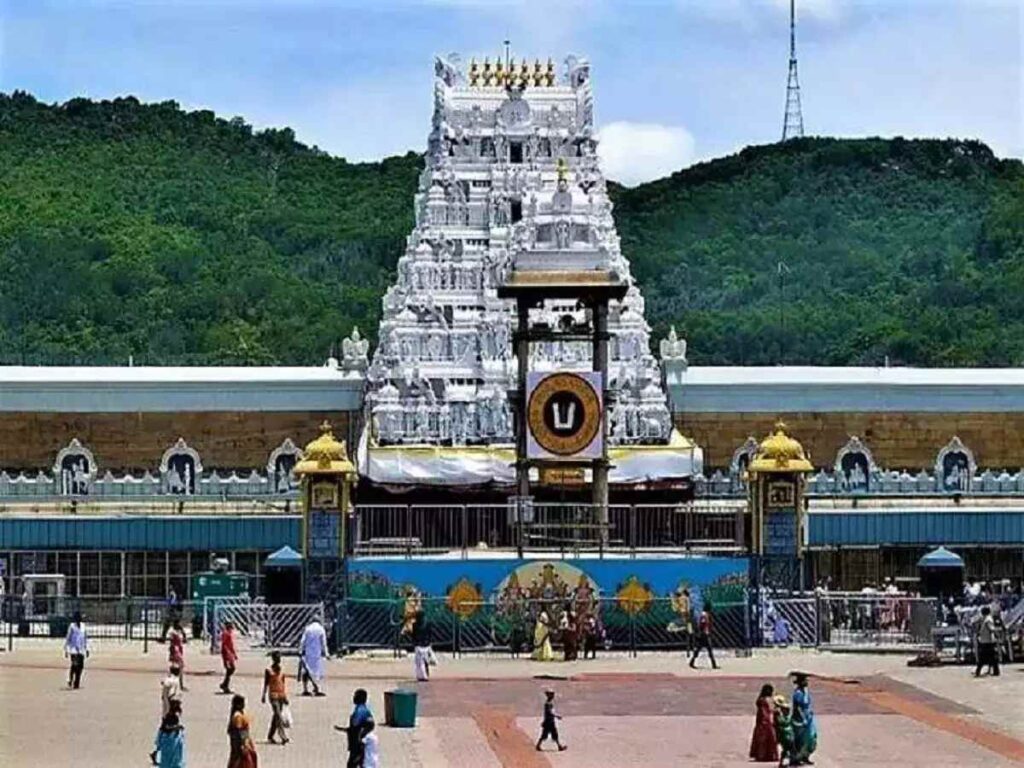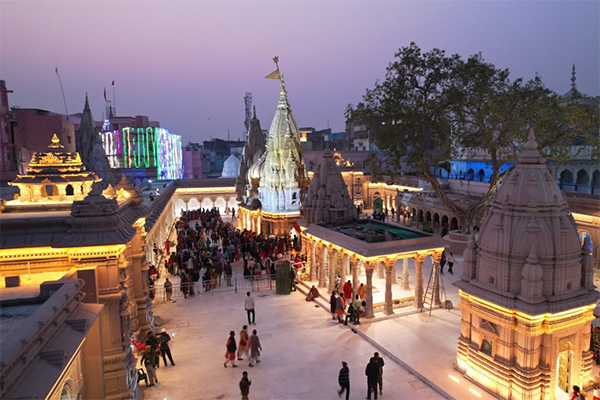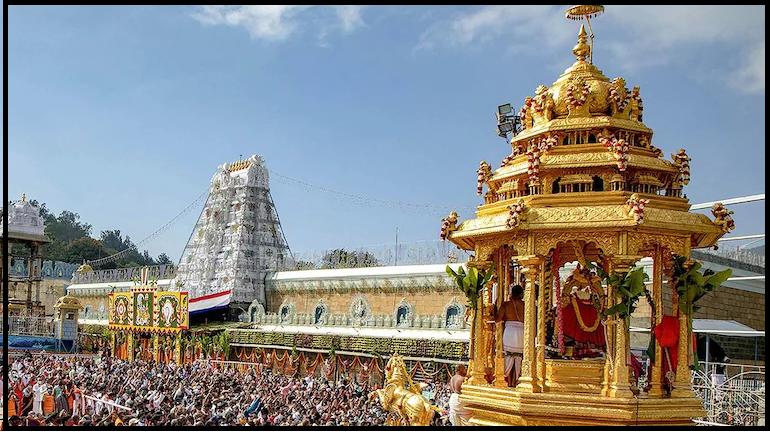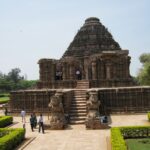The top famous temples in India. India is known as the “Land of Temples” because it has many temples throughout the country. These range from ancient caves cut into rocks to large temple buildings. Two of the most famous temples are the Tirumala Venkateswara Temple in Andhra Pradesh and the Kashi Vishwanath Temple in Varanasi. These temples are essential not just for worship but also for their rich culture and history.
1. Tirumala Venkateswara Temple in Tirupati, Andhra Pradesh: famous temples in India

Tirupati Temple, also called the Tirumala Venkateswara Temple, a famous temple in India, stands as one of the maximum revered and visited Hindu temples inside the international. Dedicated to Lord Venkateswara, an incarnation of Vishnu, this sacred shrine atop the Tirumala Hills in Andhra Pradesh draws tens of millions of devotees annually, reflecting its tremendous nonsecular, cultural, and historical significance.
Overview of famous temples in India
- Location: One of the famous temples in India is on the seventh hill (Venkatadri) in the Tirumala Hills, about 3,200 feet high, in Tirupati, Andhra Pradesh.
- Deity: It is dedicated to Lord Vishnu, known here as Sri Venkates, Balaji, or Govinda. He is believed to bring wealth and happiness to his followers and help them in this age (Kali Yuga).
- Significance: This is one of the world’s wealthiest and most famous temples in India, with 50,000 to 100,000 visitors each day, especially during festivals.
- Many believe the temple is a special place where Lord Vishnu blesses people, bringing them prosperity, health, and spiritual well-being.
- It’s essential in Hindus’ Vaishnavism tradition and is mentioned in ancient Tamil writings.
- Visitors often make promises, like offering their hair as a sign of thanks to the Lord.
Historical Background: famous temples in India
- Origins: This is a famous temple in India. The temple has a rich history surrounded by myth. It is said that Lord Vishnu took the form of Venkateswara to help humanity in the Kali Yuga. The main idol in the temple is believed to have appeared on its own.
- Historical records highlight its importance starting in the 8th and 9th centuries, with references from old dynasties like the Chola, Pallava, and Pandya.
- Development: The temple grew under the Vijayanagara Empire (14th to 16th centuries), which helped build the temple’s structure and provided funds.
- Later, support continued from the Marathas, Nawabs, and British rulers.
- Today, the temple is managed by the Tirumala Tirupati Devasthanams (TTD), a trust set up in 1933 to oversee its activities.
- Key Events: Over time, the famous temple in India became wealthier due to donations of gold, gems, and land from many kings and devotees.
- The golden canopy over the main idol, Ananda Nilayam, was added in the 15th century.
Architectural Highlights of famous temples in India
- Style: The temple showcases Dravidian architecture, featuring tall towers, detailed carvings, and a well-planned layout.
- Key Features:
- Main Idol: Inside the temple is an 8-foot-tall idol of Lord Venkateswara made from black stone. The idol has four arms and holds different sacred items. It is decorated with valuable jewels, including a large diamond crown.
- Ananda Nilayam: The golden roof over the main shrine, visible from afar, is a standout feature.
- Gopuram: The main entrance has a vast, beautifully carved tower, typical of South Indian temples, with sculptures of gods and legends.
- Vimana: Above the main shrine is a gold-plated tower called the Bangaru Gopuram.
- Temple Complex: The temple area covers 26 acres and includes smaller temples for Lord Rama, Lord Krishna, Goddess Lakshmi, and others, plus halls for rituals and gatherings.
- Sampangi Pradakshinam: A path around the main shrine is decorated with sculptures and used by devotees for circumambulation.
- Associated Temple: The Sri Padmavati Ammavari Temple, located about 5 km away in Tiruchanur, is dedicated to Goddess Padmavati, who is married to Venkateswara. Many visitors go to both temples.
- Craftsmanship: The temple is known for its intricate stone carvings, bronze statues, and woodwork, showing the skill of ancient artisans from South India.
- Main Idol: Inside the temple is an 8-foot-tall idol of Lord Venkateswara made from black stone. The idol has four arms and holds different sacred items. It is decorated with valuable jewels, including a large diamond crown.
Rituals and Offerings of famous temples in India
- Daily Rituals:
- Suprabhatam: A devotional song sung at dawn to awaken Lord Venkateswara, filling the temple with serenity.
- Abhishekham: The idol is bathed with holy water, milk, and other substances.
- Naivedyam: Daily food offerings prepared in a dedicated kitchen.
- Archana and Sevas: Various worship services like Thomala Seva, Kalyanotsavam, and Sahasra Deepalankarana Seva are performed.
- Offerings:
- Devotees offer money, gold, jewelry, and human hair, with the latter auctioned after tonsuring rituals.
- The temple’s hundi (donation box) collects vast sums, contributing to its status as one of the world’s richest temples (net worth over ₹3 lakh crore as of 2023).
- Prasadam: The famous Tirupati Laddu, made by TTD, is a sacred offering distributed to devotees.
- Tonsuring: Devotees shave their heads as a symbol of surrender, a tradition linked to a legend where Neela Devi offered her hair to Lord Venkateswara.
Festivals and Events
- Sri Venkateswara Brahmotsavam: A nine-day festival in September/October featuring processions of the deity Malayappa with Sridevi and Bhudevi on various vahanams (vehicles), with the Garuda Seva being the highlight.
- Vaikuntha Ekadasi: Celebrated in December/January, when the Vaikuntha Dwaram is opened for 10 days, believed to grant access to Vishnu’s abode.
- Rathasapthami: In February, Malayappa is taken in a procession on seven vahanams.
- Other Festivals: Rama Navami, Janmashtami, Ugadi, Teppotsavam, Pushpa Yagam, and Vasanthotsavam are celebrated with grandeur.
- Annaprasadam: The temple serves free meals to over 100,000 devotees daily, a hallmark of its communal dining tradition.
Pilgrimage and Accessibility
- Visitor Numbers: The temple attracts 24 million devotees annually, with daily footfall averaging 60,000 and peaking at over 100,000 during festivals.
- Darshan Types:
- Sarva Darshan: Free darshan, which may take hours or days depending on the crowd.
- Special Entry Darshan: Paid tickets for faster access.
- Divya Darshan: For devotees walking from Alipiri or Srivari Mettu.
- VIP/Break Darshan: select categories, including elders, parents with infants, and the physically handicapped.
Access Routes:
- By Road: A 23-km road from Alipiri to Tirumala, with dedicated up and down routes. APSRTC and TTD operate frequent buses.
- By Foot: Two sacred paths (Sopanamargas):
- Alipiri Mettu: 11 km, 3,550 steps, with four gopurams.
- Srivari Mettu: 2.1 km, 2,388 steps, starting from Srinivasa Mangapuram.
Nearby Attractions
- Sri Varahaswami Temple: Located north of the main temple, it is customary to visit this temple first.
- Padmavathi Temple: Dedicated to Goddess Padmavati, located in Tiruchanur, 5 km from Tirupati.
- Kapila Theertham: A Shiva temple at the foot of Tirumala Hills, known for its waterfall and cave.
- Sri Venkateswara National Park: A wildlife sanctuary with diverse fauna, ideal for trekking.
- Srivari Paadalu: The sacred site of Lord Venkateswara’s footprints on Narayanagiri Hill.
2. Kashi Vishwanath Temple, Varanasi, Uttar Pradesh: Top famous temples in India
Top famous temples in India. The Kashi Vishwanath Temple, one of the most famous and revered Hindu temples, is a beacon of spiritual significance. Dedicated to Lord Shiva, it is located in Varanasi (also known as Kashi) in the Indian state of Uttar Pradesh. This temple, with its profound spiritual importance, is one of the Twelve Jyotirlingas, the holiest Shiva temples spread across India, and holds a special place in the hearts of Hindus.

Historical Background of famous temples in India
The Kashi Vishwanath Temple, located in the ancient city of Varanasi (also called Kashi or Banaras), has a history spanning thousands of years, deeply rooted in Hindu mythology and documented through invasions, destructions, and reconstructions.
- Mythological Origins: According to the Shiva Purana, Lord Shiva manifested as a Jyotirlinga (column of light) to settle a dispute between Brahma and Vishnu over supremacy. This event is believed to have occurred in Varanasi, making it the first Jyotirlinga site. The temple’s roots are traced to ancient times, with mentions in the Skanda Purana (Kashi Khanda) and Brahmavaivarta Purana (Kashi Rahasya).
- Historical Timeline: Ancient Period: The original temple, Adi Vishveshwar, existed before recorded invasions, possibly dating back to 1490 or earlier.
- 1194 CE: Qutb-ud-din Aiba02k’s forces destroyed the temple, marking the first major invasion.
- 13th Century: Rebuilt during the reign of Delhi’s Iltutmish but demolished again under Sikander Lodhi.
- 16th Century: Raja Man Singh I and Todar Mal rebuilt the temple under Mughal Emperor Akbar’s rule.
- 1669 CE: Mughal Emperor Aurangzeb ordered its demolition, and the Gyanvapi Mosque was constructed on the site. The head priest hid the Shiva Lingam in the Jnana Vapi (Well of Wisdom) to protect it.
- 1780 CE: The current temple was constructed on an adjacent site by Maharani Ahilyabai Holkar of Indore, a Maratha queen devoted to Lord Shiva.
- 1835 CE: Maharaja Ranjit Singh of Punjab donated 800 kg of gold to plate the temple’s spire, earning it the title “Golden Temple.” The Bhosales of Nagpur contributed silver.
- Modern Management: Since January 28, 1983, the temple has been managed by a trust under the Uttar Pradesh government, with Dr. Vibhuti Narayan Singh and later Kashi Naresh overseeing operations.
- Recent Developments: In 2021, Prime Minister Narendra Modi inaugurated the Kashi Vishwanath Dham Corridor, a redevelopment project enhancing accessibility and facilities, leading to a surge in visitors (45,000 daily in 2023).
Architecture of famous temples in India
The temple is a stunning example of Nagara-style architecture, prevalent in North India, characterized by towering spires (shikhara) converging at the top.

- Structure: Main Temple: A quadrangular complex with a gold-plated spire (15.5 meters tall) and a golden dome. The spire is topped with a flag and trident, symbolizing Shiva’s presence.
- Sanctum Sanctorum (Garbha Griha): Houses the Jyotirlinga of Lord Vishwanath, a Shiva Lingam representing the deity as the “Ruler of the Universe.”
- Sabha Griha: A congregation hall leading to the inner sanctum.
- Jnana Vapi: A significant feature is a small well, believed to contain the original Lingam hidden during Aurangzeb’s invasion.
- Gold and Silver: The temple’s two domes are covered with 800 kg of gold donated by Maharaja Ranjit Singh, and silver contributions came from the Bhosales of Nagpur.
- Smaller Shrines: The complex includes shrines to Kala Bhairava, Kartikeya, Avimukteshwara, Vishnu, Ganesha, Shani, Parvati, and Maa Shringar Gauri. Five additional lingams form the Nilakantheshvar Temple cluster.
- Mandapas: The temple historically had five halls, with the Lingam in the innermost sanctuary, as per the Kashi Khanda.
- Corridor Enhancements: The 2021 redevelopment expanded the premises, restored old temples, and added modern facilities while preserving the Nagara aesthetic.
Rituals and Offerings
The temple is vibrant with daily rituals, aartis, and special pujas, many of which follow ancient traditions.
- Daily Aartis (Timings): Mangala Aarti: 3:00 AM–4:00 AM, performed during the Brahma Muhurta, marked by mantra chanting and bell ringing.
- Bhoga Aarti: 11:15 AM–12:20 PM, involves offering food to Lord Shiva, distributed as prasadam.
- Sandhya Aarti: 7:00 PM–8:15 PM, an evening ritual with devotional fervor.
- Shringara Aarti, 9:00–10:15 PM, involves decorating the Lingam with flowers and ornaments.
- Shayana Aarti: 10:30–11:00 PM, the final aarti before the deity “rests.”
- Special Rituals: Rudrabhishek: A ceremonial bath of the Lingam with Panchamrit (milk, curd, ghee, honey, and sugar) and chants from the Yajur Veda’s Sri Rudram.
- Sapta Rishi Aarti: A 750-year-old ritual where seven priests from different Gotras perform a synchronized aarti, believed to invoke the Saptarishis.
- Laksha Bilva Patra Puja: Offering 100,000 bel leaves, significant for Shiva worship.
- Akhand Jyoti: Lighting an eternal lamp to eradicate sorrows, available through donations.
- Dress Code for Sparsh Darshan (touching the Lingam): Men: Dhoti-Kurta
- Women: Saree
- Western attire (jeans, suits) restricts devotees from viewing outside the sanctum.
- Offerings: Devotees offer milk, bel leaves, flowers, and donations. The temple trust provides online platforms for global contributions, with 80G tax exemptions for Indian citizens.
Festivals and Events
- Mahashivaratri: A grand procession from Mahamrityunjaya Temple to Kashi Vishwanath, with heightened celebrations and aartis.
- Shravan Month: Special pujas, especially on Mondays, with feasts for people in need organized by the trust.
- Purnima: Full moon days are marked by rituals celebrating Shiva’s divine energy.
- Kumbhabhishekham: A consecration ceremony held in 2018 after 239 years, conducted by the Nattukottai Nagarathar community.
- Other Events: The temple’s multipurpose hall hosts religious gatherings, bhajan sandhyas, and cultural events like pre-wedding rituals and anniversaries, with in-house vegetarian catering (no onion or garlic).
Location and Accessibility
- Location: The temple is situated in Vishwanath Gali, a narrow lane in the old city of Varanasi, near Dashashwamedh Ghat on the western bank of the Ganges. Its precise address is Lahori Tola, Varanasi, Uttar Pradesh, 221001.
- Geographical Significance: Varanasi, one of the world’s oldest continuously inhabited cities, is India’s spiritual capital. The temple’s proximity to the Ganges enhances its sanctity, as bathing in the river is believed to aid in achieving moksha.
- How to Reach: By Air: Lal Bahadur Shastri International Airport (VNS), 20–25 km away, connects to major Indian cities like Delhi, Mumbai, and Kolkata. Taxis or app-based cabs take ~1 hour to reach the temple.
- By Train: Varanasi Junction (6 km), Varanasi City Station (2 km), Banaras Station (4 km), and Pandit Deen Dayal Upadhyaya Junction (17 km) are nearby. Auto-rickshaws, cycle-rickshaws, or taxis cover the distance to Vishwanath Gali.
- By Road: Varanasi is well-connected via national and state highways. Buses and taxis operate from cities like Delhi, Lucknow, and Allahabad. The temple is accessed on foot or by cycle-rickshaw through Vishwanath Gali, as the lane is non-motorable.
- Navigation Tip: Use Gate 4 for quicker access with shorter queues, especially for Sugam Darshan or VIP Break Darshan.
- Kashi Vishwanath Corridor: Stretching 800 meters from the temple to Manikarnika Ghat, the corridor includes amenities like shops, restaurants, and over 1.5 million lamps, easing crowd movement and enhancing the pilgrimage experience.
Pilgrimage and Visitor Information
- Visitor Numbers: The temple sees ~45,000 pilgrims daily, with peaks during festivals like Mahashivaratri and Shravan.
- Darshan Types: General Darshan: Free, but involves long queues, especially at the Godowlia market entrance.
- Sugam Darshan: INR 300, includes a priest escort, locker, and prasadam, available 6:00 AM–6:00 PM.
- VIP Break Darshan: Fast-track access for special categories, bookable online or at counters.
- Differently Abled: Free darshan with no fee charged by the temple trust.
- Visiting Tips: Timings: Open daily 4:00 AM–11:00 PM. Early mornings (post-Mangala Aarti) are less crowded.
- Security: Cameras, mobiles, and electronic devices are prohibited inside; deposit them in lockers. Foreigners enter via Gate 2.
- Dress Code: Modest attire; cover heads before entering.
- Vishwanath Gali: A bustling lane with shops selling pooja items, Banarasi sarees, sweets, and devotional articles.
- Facilities: Accommodation: Southern Grand (Bhimashankar Guest House) offers super deluxe rooms and dormitories in the corridor.
- Dining: Prasadam Restaurant (ground floor) and a rooftop multi-cuisine restaurant serve vegetarian meals (no onion/garlic).
- Online Services: Book darshan, accommodations, and donations via www.shrikashivishwanath.org. Live Jyotirlinga viewing is available for remote devotees.
- Kashi Yatra Scheme: The Karnataka government offers INR 5,000 subsidies for pilgrims visiting Varanasi.
Nearby Attractions of famous temples in India
- Annapurna Devi Temple: Near the temple, dedicated to the Goddess of Food.
- Sankat Mochan Hanuman Temple: A significant site for Hanuman devotees.
- Kaal Bhairav Temple: Known as the “Kotwal of Varanasi,” believed to guard the city.
- Dashashwamedh Ghat: 0.5 km away, famous for the Ganga Aarti.
- Manikarnika Ghat: A cremation ghat linked to Shiva’s legends.
- New Vishwanath Temple (BHU): A replica of Kashi Vishwanath, built by the Birla family (1931–1966), with a 250-foot shikhara.
- Sarnath: 10 km away, where Buddha delivered his first sermon.

